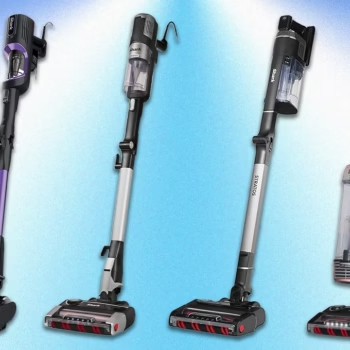Winter has a knack for creeping into homes, even with central heating cranked up. Drafty living room corners, home offices that never warm up, bathrooms resembling iceboxes — spots like these practically beg for a space heater. But picking the right one in 2025? Overwhelming, with shelves and online stores packed with options. To simplify things, we’ve spent months testing new models. This guide cuts through the noise to help you find a cozy, efficient match for those frosty days ahead.
What is a Space Heater?
Picture a gadget that warms up just the area you’re in — not a whole house. It’s like having a toasty spotlight you can lug from room to room. While central heating blasts every corner (even ones you never use), portable heaters zero in on spots you actually occupy. Result? Less energy wasted, more cash saved.
These devices come in various types:
- Ceramic heaters: Fast heating with fan-assisted heat distribution
- Oil-filled radiators: Slow to warm up but retain heat longer
- Infrared heaters: Direct radiant heat toward objects and people
- Micathermic heaters: Combine convection and radiant heating
- Fan heaters: Lightweight and quick to heat small areas
Modern space heaters feature safety mechanisms like tip-over protection, overheat shutoff, and cool-touch exteriors — essential safeguards that have transformed these devices from the fire hazards of yesteryear into relatively safe home appliances.
List of the Best Space Heaters
| Model | Type | Max Power | Special Features | Price Range |
| Vornado VH200 | Vortex air circulation | 1500W | Whole-room heating | $70-90 |
| De’Longhi TRD40615T | Oil-filled radiator | 1500W | Silent operation | $110-150 |
| Dreo Solaris Slim H3 | Ceramic | 1500W | Ultra-slim design | $70-90 |
| Dyson Purifier Hot + Cool HP07 | Bladeless fan/heater | 1500W | Air purification | $500-700 |
| De’longhi HMP1500 | Mica panel | 1500W | Wall-mountable | $80-120 |
| Ellipse Ceramic Tabletop | Ceramic | 1500W | Compact design | $50-70 |
| Honeywell Uberheat 5 | Ceramic | 1500W | Budget-friendly | $30-50 |
| Dreo Solaris 718 | Ceramic tower | 1500W | Oscillation | $120-140 |
Vornado VH200
The Vornado VH200 isn’t just another space heater — it’s practically a marvel of air circulation engineering. Using Vornado’s signature “vortex action” technology, this unassuming device moves warm air throughout your entire room rather than just creating a hot spot directly in front of it.
Pros:
- Heats entire rooms evenly through unique air circulation
- Remarkably quiet operation (whisper-like at lowest setting)
- Housing remains cool to touch even during operation
- Simple, intuitive controls
- 5-year warranty exceeds industry standard
- Tip-over protection and overheat shutoff
Cons:
- No digital display
- No remote control
- No summer fan-only mode
- Mechanical thermostat less precise than digital
- Higher initial cost than basic models
The VH200 is ideal for anyone seeking the best space heater that provides consistent warmth without the noise and hot spots common with cheaper models.
De’Longhi TRD40615T
The De’Longhi TRD40615T oil-filled radiator represents the pinnacle of silent heating technology. Unlike fan-based heaters, this radiator operates with absolutely no noise — perfect for bedrooms, offices, or anywhere you need warmth without distraction.
Pros:
- Completely silent operation
- Maintains heat long after being turned off
- Pre-assembled with no setup required
- Digital controls with 24-hour programmable timer
- Three heat settings for customized comfort
- Built-in antifreeze function prevents pipes from freezing
Cons:
- Slow to initially heat up (15-20 minutes)
- Heavier and less portable than ceramic models
- Exterior becomes hot to touch
- Takes up more floor space than tower models
- Higher electricity usage during initial heating
The TRD40615T represents the best space heater for large room scenarios where consistent, gentle heat is preferred over quick blasts of warmth. Its thermal mass means it continues radiating heat even after being turned off, making it an energy efficient heater for overnight use.
Dreo Solaris Slim H3 (DR-HSH003)
The Dreo Solaris Slim H3 represents a breakthrough in portable heater design, with its ultra-slim profile (just 2 inches thick) that delivers surprising heating power. This ceramic heater combines modern aesthetics with cutting-edge functionality.
Pros:
- Incredibly slim design takes minimal space
- 70° oscillation for wide heat distribution
- Touch controls with LED display
- 1-12 hour timer function
- ECO mode automatically adjusts output to save energy
- Quiet operation (as low as 40dB)
Cons:
- Touch controls can be overly sensitive
- Thermostat readings sometimes inconsistent
- Light indicators may be too bright for bedroom use
- Limited color options (only available in white)
- Fan continues briefly after turning off
During our tests, the Solaris Slim H3 proved itself as the most efficient space heater in compact spaces like bathrooms or small offices. Its slender profile means you can place it almost anywhere, and the wide oscillation ensures even heating throughout the room.
Dyson Purifier Hot + Cool HP07
The Dyson Purifier Hot + Cool HP07 transcends the category of mere space heaters to deliver a year-round climate control and air purification system. Yes, it’s expensive — but it’s essentially three premium devices in one sleek package.
Pros:
- Combines heating, cooling, and air purification
- HEPA filtration captures 99.97% of particles
- Bladeless design is child and pet friendly
- App control with air quality monitoring
- Precise digital thermostat
- Remarkably even heat distribution
- Programmable timer and sleep timer
Cons:
- Significantly higher price point
- App requires smartphone connectivity
- Replacement filters add to long-term cost
- Fan noise noticeable at highest settings
- Takes up more visual space than conventional heaters
The HP07 represents the best electric heater for those concerned about air quality as well as temperature. During testing, we found it could maintain temperature within 1°F of the setting — a precision rarely seen in the space heaters market.
De’longhi HMP1500 Mica Panel Heater

The De’longhi HMP1500 Mica Panel Heater uses innovative micathermic technology — combining both convection and radiant heating methods for efficient warmth. Its slim, wall-mountable design makes it one of the most versatile room heaters available.
Pros:
- Ultra-thin profile (just 3 inches deep)
- Can be used freestanding or wall-mounted
- Completely silent operation (no fan)
- Heats up in seconds
- Adjustable thermostat with two heat settings
- Wheels and handle for easy mobility
Cons:
- Surface gets hot to touch
- No digital display or remote
- Limited features compared to smart models
- Wall mounting hardware requires separate purchase
- No oscillation function
The HMP1500 excels as a small space heater for permanent installations where aesthetics matter. Its panel design means it can blend into your decor like a radiator rather than standing out as an appliance.
Ellipse Ceramic Tabletop Heater
The Ellipse Ceramic Tabletop Heater from Lasko delivers immediate, focused heat in a compact, budget-friendly package. This small heater proves that effective heating doesn’t require complicated features or a large footprint.
Pros:
- Instant heat within seconds of turning on
- Compact size fits on desktops or small tables
- Oscillation feature spreads warmth evenly
- Remote control included
- Digital thermostat with temperature display
- Programmable timer up to 8 hours
Cons:
- Front grill gets very hot during operation
- Limited range of heat distribution
- Louder than premium models
- Not suitable for heating large spaces
- Plastic housing feels less durable than metal alternatives
During our testing, the Ellipse proved itself as the safest space heater in its price range, with reliable tip-over protection and overheat shutoff that activated within seconds.
Honeywell Uberheat 5 Ceramic Space Heater
The Honeywell Uberheat 5 delivers no-nonsense heating performance in a refreshingly straightforward package. Built like a toolbox and just as reliable, this portable heater is made for places where grit trumps glam — think garages cluttered with tools, dusty workshops, or damp basements that’d fry pricier models.
Pros:
- Remarkably powerful output for its compact size
- Distinctive design with integrated carry handle
- Two heat settings (900W and 1500W)
- Adjustable thermostat with auto-shutoff
- Cool-touch housing even during operation
- Budget-friendly price point
Cons:
- No digital display or remote control
- Limited to basic heating functions
- Louder than premium models
- No oscillation feature
- Mechanical thermostat less precise than digital
Why call it the best portable heater for utility zones? It won’t win design awards, but it nails the essentials: heat that kicks in quickly, construction that lasts, and a price that won’t make you wince. No timers, no remotes, no apps — just a plug-and-warm workhorse for when you need to thaw pipes, dry paint, or take the edge off a chilly workbench.
Dreo Solaris 718
The Dreo Solaris 718 tower heater combines sleek aesthetics with remarkably quiet operation, making it an excellent choice for bedrooms and living spaces where noise disruption is a concern.
Pros:
- Whisper-quiet operation (as low as 37dB)
- Elegant tower design with small footprint
- 70° oscillation for wide coverage
- Remote control included
- ECO mode for energy efficiency
- 1-12 hour timer with auto shut-off
Cons:
- Thermostat readings can be inconsistent
- Base feels slightly unstable on carpet
- Limited color options
- Display lights cannot be fully dimmed for nighttime use
- Remote requires direct line-of-sight
Designed to stand tall rather than sprawl outward, it prioritizes vertical space, slipping easily behind furniture or into narrow gaps between walls and desks. While it’s not the strongest heater for large, drafty spaces, the Solaris 718 nails quiet, efficient warmth for small to medium rooms. It’s built for blending in, not standing out — a practical pick if you value subtle design and low hum over raw power or flashy features.
How We Test Space Heaters
Our testing methodology goes beyond manufacturers’ claims to evaluate real-world performance. After all, what good is a space heater that looks great on paper but leaves you shivering?
Each model undergoes a rigorous evaluation process:
- Heating efficiency: We measure how quickly each heater raises the temperature in a standardized 10×10 room, taking readings at 5-minute intervals.
- Heat distribution: Using multiple thermometers positioned throughout the test room, we assess how evenly each heater distributes warmth.
- Noise levels: Using a decibel meter, we measure operational noise at various distances and settings.
- Safety features: We deliberately trigger safety features like tip-over protection and overheat shutoff to verify they function properly.
- Surface temperature: We use infrared thermometers to measure exterior surface temperatures during operation.
- Energy consumption: Using a watt meter, we track actual power usage across different settings.
- Long-term testing: Selected models undergo extended testing in staff homes to evaluate durability and performance over time.
This comprehensive approach ensures our recommendations reflect actual performance rather than marketing hype. We’ve eliminated numerous models that failed our safety tests or performed poorly in real-world conditions.
Best Space Heaters of 2025: Buying Guide
Choosing a model among the best space heaters involves considering your specific needs and circumstances. Here’s what to evaluate before making your purchase:
Heating Technology
Different heating technologies serve different purposes:
- Ceramic heaters: Fast heating, good for quickly warming small to medium spaces
- Oil-filled radiators: Slow to heat up but maintain warmth efficiently, ideal for continuous operation
- Infrared heaters: Direct heat toward people and objects rather than warming air, perfect for drafty spaces
- Micathermic heaters: Combine convection and radiation for balanced heating
- Fan-forced heaters: Lightweight and portable, would be the best room heater for personal usage
Room Size
Match your heater to your space:
- Small spaces (up to 150 sq ft): 750-1000W heaters usually sufficient
- Medium rooms (150-300 sq ft): Look for 1000-1500W models
- Large rooms (300+ sq ft): Consider multiple heaters or a specialized heater for large room
Safety Features
Never compromise on safety:
- Tip-over protection: Automatically shuts off if the heater falls over
- Overheat protection: Prevents dangerous overheating
- Cool-touch exterior: Reduces burn risk, especially important with children or pets
- ALCI plug: Required for bathroom use to prevent electrical shock
- Certification: Look for UL, ETL, or CSA certification
Energy Efficiency
An energy efficient space heater can save money long-term:
- Look for models with thermostats that maintain temperature rather than running continuously
- ECO modes that adjust power based on needs
- Timers that prevent unnecessary operation
- Consider the wattage — higher isn’t always better if it’s wasting energy
Noise Level
Operational noise varies dramatically between models:
- Oil-filled radiators offer silent operation
- Ceramic heaters with quality fans can be relatively quiet (40-45dB)
- Cheaper fan-forced models can exceed 60dB, disruptive for sleeping or working
Additional Features
Consider which conveniences matter to you:
- Digital thermostats for precise temperature control
- Remote controls for adjustment without leaving your chair
- Programmable timers for scheduled operation
- Oscillation for wider heat distribution
- Portability features like wheels or handles
Conclusion
After months of testing heaters in real rooms (and a few drafty garages), one model consistently rose above the rest: Vornado’s VH200. It’s not the cheapest, but balances even heat distribution, quiet hum, and safety tech better than rivals — earning its spot as our best space heater pick for 2025.
For those with specific needs, our other recommendations offer targeted solutions:
- Silent operation: De’Longhi TRD40615T oil-filled radiator
- Compact spaces: Dreo Solaris Slim H3
- Air quality concerns: Dyson Purifier Hot + Cool HP07
- Wall mounting: De’longhi HMP1500 Mica Panel
- Budget option: Honeywell Uberheat 5
- Bedroom use: Dreo Solaris 718
Those best space heaters 2025 praised for efficiency? Their 2025 upgrades added extra safeguards, sharper thermostats, and smarter energy use. Modern electric space heaters now excel at zone heating, letting you warm just the spots you use instead of cranking up the whole-house system. Smarter temp control could mean lower bills over time — if you resist the urge to roast every room.
Even the safest heater demands common sense. Keep fabrics and furniture three feet clear. Never run one overnight unattended (yes, even if you’re positive it’s fine). And plug directly into wall outlets — extension cords are a gamble you don’t want to take. Heat smart, stay cozy.
FAQs
What to consider when shopping for a space heater?
First, safety’s non-negotiable: auto-shutoff if your heater tips or overheats. Size matters too — your heater’s wattage should match your room. Aim for 10 watts per square foot (so a 1500W model handles a medium bedroom). Listen for decibel ratings if you plan to use it where silence matters, like beside a desk or bed. Heat style also varies: ceramic or fan-driven units blast heat fast; oil-filled radiators simmer warmth slowly. Lastly, look for timers or smart thermostats to avoid roasting an empty room.
Do space heaters use a lot of electricity?
They can, but it’s not all doom and gloom. Most electric heaters run between 750-1500 watts. Crank one up to max, and you’re burning through 1.5 kilowatt-hours every 60 minutes. At typical rates, that’s like leaving 15 LED bulbs blazing nonstop — costing around $5 daily if left running 24/7. Yet, heaters with smart thermostats click off once rooms hit target temps, slicing that bill by 30-50%. Grab an energy efficient heater with ECO mode, and it’ll tweak power automatically, keeping costs down without freezing your toes.
How do space heaters work?
Different heaters play by different rules. Some types channel juice through ceramic plates, which warm up and pass heat to metal fins; a built-in fan then pushes that toasty air around. Others skip the breeze entirely — think metal columns filled with oil that gets heated, then slowly releases warmth like a radiator in an old apartment. Ever stood near one of those glowing bars at a patio restaurant? That’s infrared tech: invisible rays that heat you directly, not the surrounding air. Basic models? Just a metal coil that sizzles when powered up, plus a fan to blow the heat your way. All versions flip electrical energy into warmth, but how they spread it — and how much juice they gulp — varies wildly.
Is it cheaper to run space heaters or central heat?
If you’re only warming spots you actually use — like a home office or living room — a portable heater paired with lowered central temps can shave 10-40% off bills. But trying to heat every corner of your house with multiple units will likely cost more than just running your furnace.
Gas systems have an edge — they squeeze 1.5-2.5x more heat from each energy unit compared to even the most efficient heater, which converts power to warmth at a 1:1 rate. Gas stays cheaper for whole-house heating.
Set central heating low (think 60-65°F) as a base, then deploy heaters where people gather. Bonus points if you seal drafts first.





